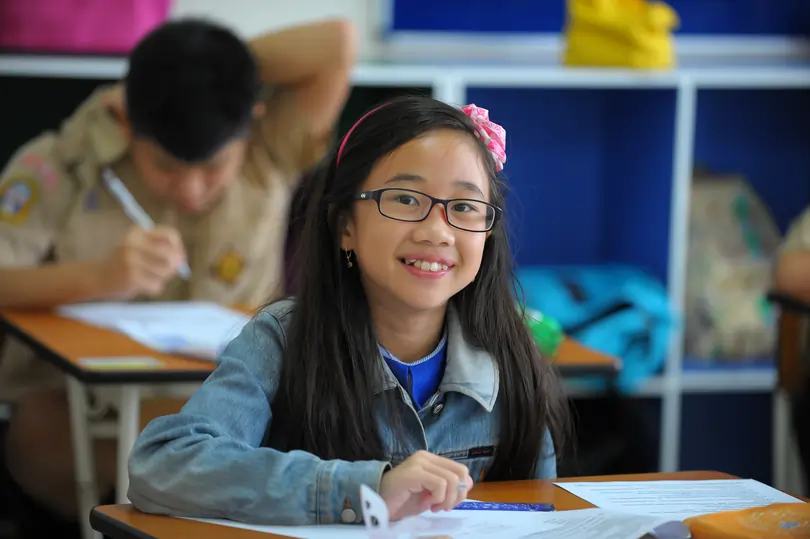Whole Numbers 6
In this article, the learning objectives are:
- Equal stage at the beginning
- Equal stage in the end
1. Equal stage at the beginning
Both subjects have the same number of items at first. After some items are added/removed from each subject, they each have a different number of items in the end.
Question 1:
Mrs Tan and Mrs Lim had an equal number of pies at first. After Mrs Tan bought another 12 pies and Mrs Lim gave away 4 pies, Mrs Tan had twice as many pies as Mrs Lim. How many pies did each of them have at first?
Solution:
\(\begin{align} 1 \text{ unit} &= 12 + 4\\[2ex] &= 16 \end{align}\)
Number of pies each of them have at first\(\begin{align}\\[2ex] &= 16 + 4\\[2ex] &= 20 \end{align}\)
Each of them had 20 pies at first.
Answer:
20 pies
Question 2:
Rajesh and Charles had an equal number of stickers. After Rajesh bought another 24 stickers and Charles lost 12 stickers, Rajesh had thrice as many stickers as Charles. Find the number of stickers Rajesh had at first.
Solution:
Difference in units\(\begin{align}\\[2ex] &= 3 \text{ units} - 1 \text{ unit}\\[2ex] &= 2 \text{ units} \end{align}\)
\(\begin{align} 2 \text{ units} &= 12 + 24\\[2ex] &= 36\\[2ex] 1 \text{ unit} &= 36 \div 2\\[2ex] & = 18 \end{align}\)
Number of stickers Rajesh had at first \(=\) Number of stickers Charles had at first
Number of stickers Charles had at first\(\begin{align}\\[6ex] &= 1 \text{ unit} + 12\\[2ex] &= 18 +12\\[2ex] &= 30 \end{align} \)
Rajesh had 30 stickers at first.
Answer:
30 stickers
Question 3:
Wendy and Yvonne had the same number of paper cups. After Wendy bought another 70 paper cups and Yvonne bought another 6 paper cups, Wendy had five times as many paper cups as Yvonne. How many paper cups did Wendy have in the end?
Solution:
Difference in units\(\begin{align}\\[2ex] &= 5 \text{ units} - 1 \text{ unit}\\[2ex] &= 4 \text{ units} \end{align}\)
\(\begin{align} 4 \text{ units} &= 70-6\\[2ex] &= 64\\[2ex] 1 \text{ unit} &= 64 \div 4\\[2ex] & = 16 \end{align}\)
Number of paper cups Wendy had in the end\(\begin{align}\\[6ex] &= 5 \text{ unit}\\[2ex] &= 5 \times 16\\[2ex] &= 80 \end{align} \)
Wendy had 80 paper cups in the end.
Answer:
80 paper cups
Question 4:
Wilson and Ryan had an equal number of marbles. After Wilson lost 16 marbles and Ryan gave away 4 marbles, Ryan had thrice as many marbles as Wilson. How many marbles did Ryan have at first?
Solution:
Difference in units\(\begin{align}\\[2ex] &= 3 \text{ units} - 1 \text{ unit}\\[2ex] &= 2 \text{ units} \end{align}\)
\(\begin{align} 2 \text{ units} &= 16-4\\[2ex] &= 12\\[2ex] 1 \text{ unit} &= 12 \div 2\\[2ex] & = 6 \end{align}\)
Number of marbles Ryan had at first \(=\) Number of marbles Wilson had at first
Number of marbles Wilson had at first\(\begin{align}\\[6ex] &= 1 \text{ unit} +16\\[2ex] &= 6+16\\[2ex] &= 22 \end{align} \)
Ryan had 22 marbles at first.
Answer:
22 marbles
2. Equal stage in the end
Both subjects have a different number of items at first. After some items are added/removed from each subject, they have the same number of items in the end.
Question 1:
Mrs Lim had four times as many biscuits as Mrs Goh. After Mrs Lim gave away 17 biscuits and Mrs Goh received another 4 biscuits, they had an equal number of biscuits. How many biscuits did Mrs Goh have in the end?
Solution:
Difference in units\(\begin{align}\\[2ex] &= 4 \text{ units} - 1 \text{ unit}\\[2ex] &= 3 \text{ units} \end{align}\)
\(\begin{align} 3 \text{ units} &= 4+17\\[2ex] &= 21\\[2ex] 1 \text{ unit} &= 21 \div 3\\[2ex] & = 7 \end{align}\)
Number of biscuits Mrs Goh had in the end\(\begin{align}\\[6ex] &= 1 \text{ unit} +4\\[2ex] &= 7+4\\[2ex] &= 11 \end{align} \)
Mrs Goh had 11 biscuits in the end.
Answer:
11 biscuits
Question 2:
Alvin had four times as many marbles as Wei Ming. After Alvin lost 24 marbles and Wei Ming lost 3 marbles, both of them had the same number of marbles. How many marbles did Wei Ming have in the end?
Solution:
Difference in units\(\begin{align}\\[2ex] &= 4 \text{ units} - 1 \text{ unit}\\[2ex] &= 3 \text{ units} \end{align}\)
\(\begin{align} 3 \text{ units} &= 24-3\\[2ex] &= 21\\[2ex] 1 \text{ unit} &= 21 \div 3\\[2ex] & = 7 \end{align}\)
Number of marbles Wei Ming had in the end\(\begin{align}\\[6ex] &= 1 \text{ unit} -3\\[2ex] &= 7-3\\[2ex] &= 4 \end{align} \)
Wei Ming had 4 marbles in the end.
Answer:
4 marbles
Question 3:
The basketball team had four times as many members as the tennis team. After 4 new members joined the basketball team and 31 new members joined the tennis team, both teams had the same number of members. How many members were in the basketball team at first?
Solution:
Difference in units\(\begin{align}\\[2ex] &= 4 \text{ units} - 1 \text{ unit}\\[2ex] &= 3 \text{ units} \end{align}\)
\(\begin{align} 3 \text{ units} &= 31-4\\[2ex] &= 27\\[2ex] 1 \text{ unit} &= 27 \div 3\\[2ex] & = 9 \end{align}\)
Number of members in the basketball team at first\(\begin{align}\\[6ex] &= 4 \text{ unit} \\[2ex] &= 4 \times 9\\[2ex] &= 36 \end{align} \)
There were 36 members in the basketball team at first.
Answer:
36 members
Summary
Whole Number Strategy
-
Equal Stage
Draw a model to help you solve and find the answer!
 SG
SG  VN
VN 











